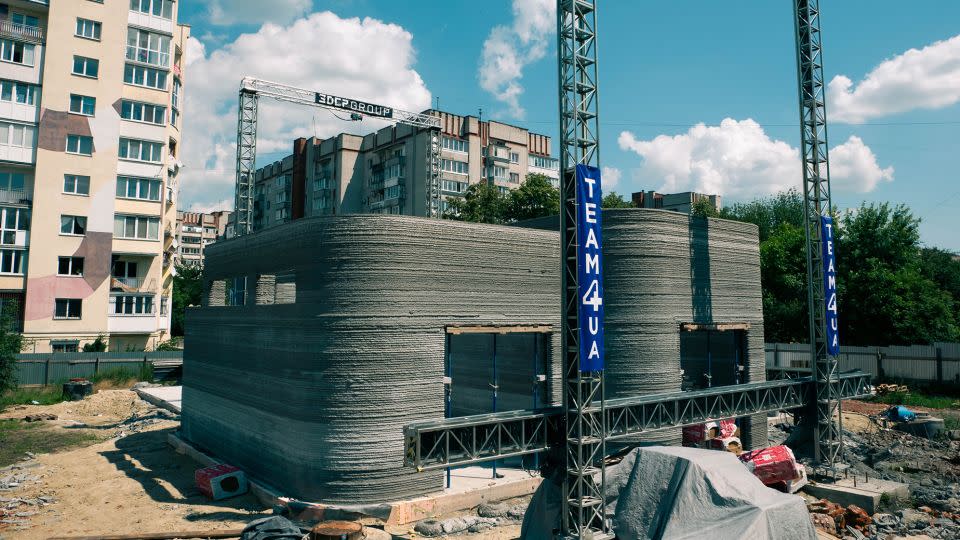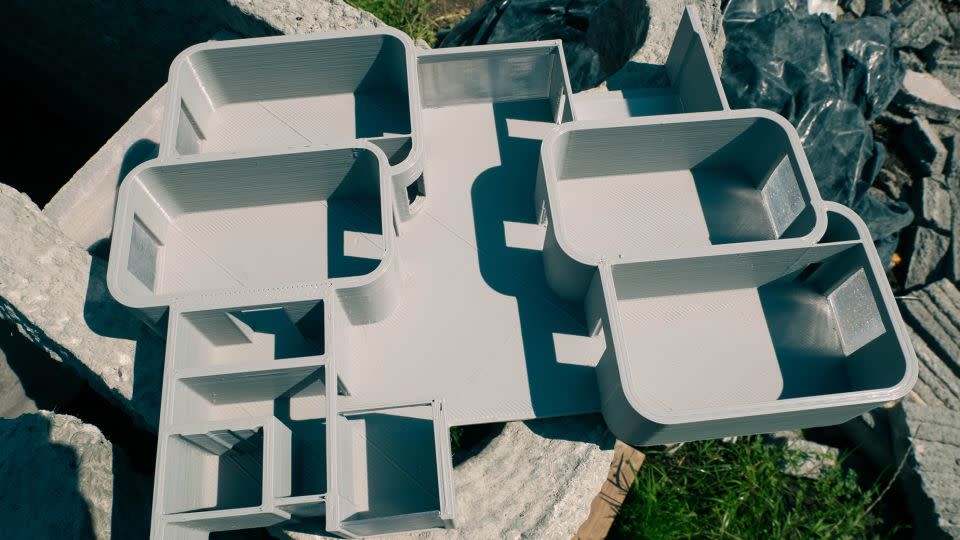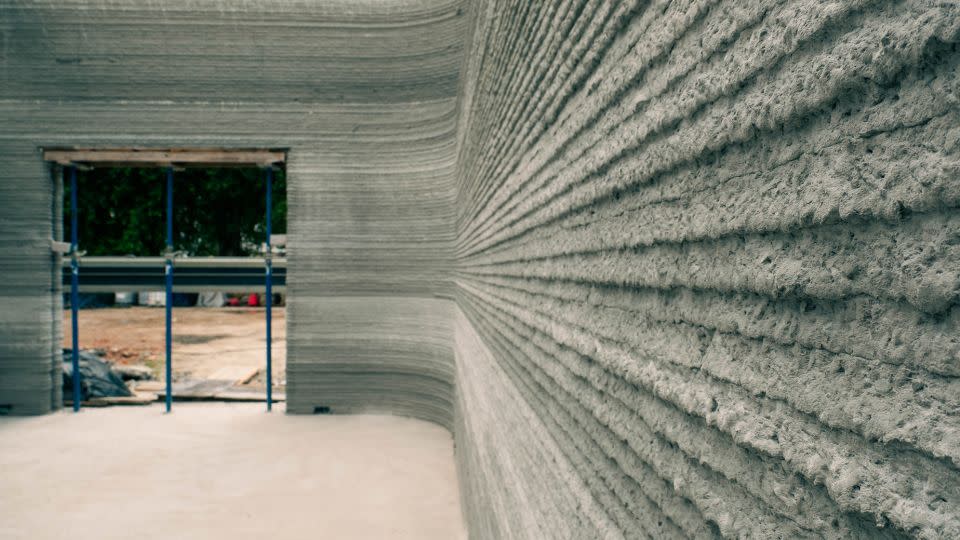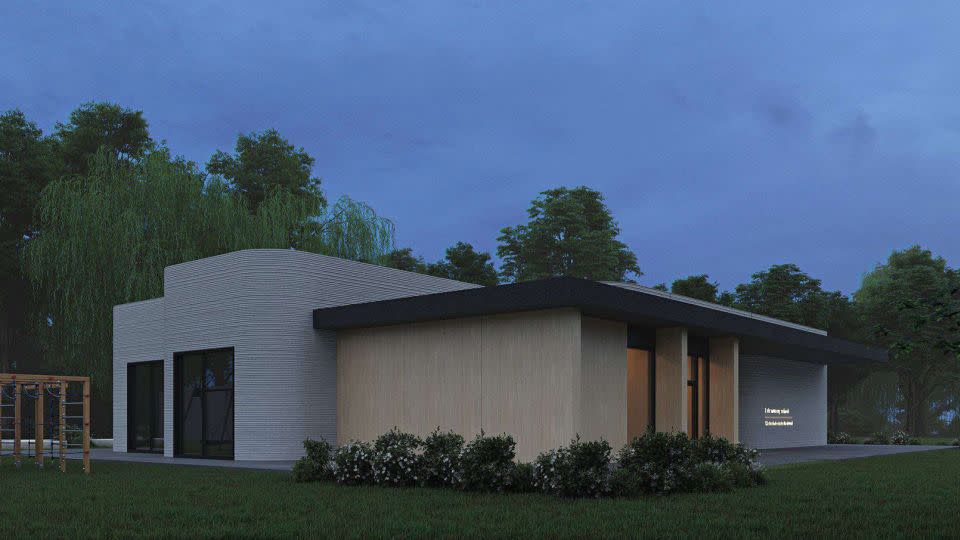How to 3D-print a school in a war zone
Editor’s Note: Design for Impact is a series spotlighting architectural solutions for communities displaced by the climate crisis, natural disasters and other humanitarian emergencies.
With its soft gray lines and sleek, curving exterior, Project Hive looks less like a school and more like a wellness retreat or modern art museum.
The structure’s distinctive appearance, with a texture resembling a cocoon or the structure’s namesake beehive, is down to the construction method used to build it: 3D printing.
Standing less than 200 feet from School No.23 in Lviv, Ukraine, the walls of the 3,983-square-foot educational facility were printed in just 40 hours with a COBOD gantry printer, which follows digital blueprints to lay concrete like piping icing onto a cake.
It’s the first 3D-printed education center in Europe and the first building to be 3D-printed in a war zone, according to Jean-Christophe Bonis, founder of Team4UA, the non-profit responsible for the pilot project.
“I’m not a builder; I don’t want to be an architect or a developer… But through robotics and AI, through technology, we can accelerate the (building) process,” Bonis told CNN in a video interview.
Soon after Russia launched its full-scale invasion of Ukraine in February 2022, places like Lviv faced a huge problem: how to cope with tens of thousands of people fleeing to — and through — the city. In the Lviv region alone, there were 173,000 internally displaced people as of December last year, according to the latest figures from the United Nations’ International Organization for Migration.
Project Hive will provide the school with four extra classrooms to help it accommodate additional students displaced by the war, said Bonis. He hopes that, if successful, the project will enable “3D printing to be one of the tools of local construction in Ukraine.”

Blackouts and bombings
3D-printed construction can be significantly faster and, some experts believe, more sustainable than traditional building methods.
Team4UA collaborated with Ukrainian studio Balbek Bureau on the school’s design, and architecture firm Ars Longa on the engineering. The single-story project broke ground in September 2022, and the entire project, from foundations to finishings, was originally expected to take just three months.
But Russian air strikes and bombing across the country through October and November 2022 hit major civilian infrastructure, including the power grid, causing widespread blackouts in Lviv. With local communities turning to power generators, Project Hive was paused while electricity supply became unstable and conditions made it unsafe for the printer to be delivered.
It wasn’t until last summer that the situation stabilized in Lviv and the power supply was fully restored, finally allowing the printer to be delivered. Although it took less than two days, cumulatively, to print the building’s concrete frame, Team4UA spread this across six weeks so it could deliver training and development sessions on site.
After revising its opening date to January 2024, the project hit another roadblock: funding. Construction costs in Ukraine have risen sharply in the past year, and to complete the final finishing work, such as roofing, windows, doors and interior design, project organizers say they need to raise another $400,000.
“I’m facing challenges on a daily basis,” said Bonis. But he continues undeterred: “(This) is also a way of taking technology to give back hope.”

A costly option
As a relatively new technology, and with limited data on the resulting buildings’ safety and stability, 3D-printed construction has predominately been used for one-off projects or research collaborations.
Dutch architecture firm DUS has been experimenting with 3D-printed houses since 2015, and Texas-based construction firm ICON has 3D-printed entire communities in Austin, Texas and Nacajuca, Mexico. In 2020, the Dubai Future Foundation became the world’s first 3D-printed commercial building, and in 2021, the world’s first 3D-printed school was completed in Malawi, with the walls laid in just 18 hours.
However, when it comes to large-scale construction, the technology is “still in its infancy,” said Christian Lange, an associate architecture professor at Hong Kong University, where he oversees the Robotic Fabrication Lab.
Lange is skeptical about the benefits of using 3D printing to build in regions with ongoing conflict or disruption.
While technology has the potential to be cheaper than conventional building methods, the up-front costs of the printers can be extremely high, and their size can make them difficult and costly to move.
According to Lange, there are cheaper, faster alternatives to 3D printing, such as prefabricated and modular buildings. Made using parts that are constructed in factories and quickly assembled on site, prefabs were popular in the early 20th century, when they were used to rebuild after World War II and provide cheap housing for displaced people.
“Temporary shelter doesn’t need to be permanent shelter,” said Lange in a phone interview. “Where 3D printing is really great is when you have special geometries and shapes, because you’re totally free — the robot or the machine doesn’t care if you build a straight wall or a curved wall.”
But in Ukraine, where many technicians, construction workers and industry experts are fighting on the front lines, automation may help counter labor shortages, said Olga Gavura, managing partner at 7CI Group, a contractor on Project Hive.
“The fact this technology helps to build with a smaller number of specialists is a significant advantage,” said Gavura, adding that just four experts were required for the construction phase of Project Hive.
As Russian airstrikes continue to devastate the nation’s infrastructure — 2024 has already seen multiple attacks targeting cities, including Lviv, killing civilians and destroying homes — Gavura believes that, for the number of structures needing to be rebuilt, 3D printing will become essential.
She believes pilots like Project Hive can not only test construction processes but will help train a generation of Ukrainian specialists who “can apply the technology, on their own, in future,” she added.

Reconstructing communities
Team4UA is not the only organization to see the potential of 3D-printed construction in disaster and conflict zones.
Arizona-based construction company Diamond Age is currently in discussion with Ukrainian officials about printing bomb shelters and military infrastructure, said the firm’s CEO Jack Oslan.
Diamond Age uses a patented 3D printing system that, it claims, insulates the buildings’ walls. Oslan said his company’s structures are 30% more energy efficient than those made from lumber frames and are strong enough to withstand a Category 5 hurricane or moderate earthquake.
“It’s this climate resiliency that gives us the perfect platform to transition into military and humanitarian applications,” he said, adding that automation could help reduce casualities when building in war zones: “There (will) be fewer people in harm’s way, which we think is important.”
Damage to Ukrainian infrastructure between Russia’s full-scale invasion and September 2023 — including homes, schools, energy grids and transport networks — will cost an estimated $151.2 billion to replace, according to a study by the Kyiv School of Economics. Researchers found that over 3,500 educational facilities were among the buildings damaged or destroyed, along with over 160,000 homes.
Oslan sees huge opportunity for 3D printing to help begin rebuilding the nation. “We would expect that anything we deliver to Ukraine today to build military or humanitarian structures would ultimately transition into the building of homes, for the reconstruction of (the country’s) communities,” he added.

‘A vision for this country’
Back in Lviv, there’s more excitement around Project Hive than one might expect for a primary school building, according to Bonis.
“When I’m on the site, I have children coming to me with their parents and telling me in Ukrainian, ‘I will be in this school, I’m so excited, my school is unique in the country’,” he said.
In an email to CNN, the head of Lviv City Council’s education department, Andriy Zakaliuk, said the project offered “a unique opportunity” to custom-build an environment for young students.
“It is symbolic that they will begin their new stage of life in a new, modern environment,” said Zakaliuk. “Now these children have the opportunity to see that, with the help of a 3D printer, you can build real buildings.”
While he awaits yet another revised opening date for the new school building, Bonis is already planning two more ambitious 3D printing projects — a bridge in Kherson, and an eight-story building in the center of Kyiv.
Team4UA hopes these pilot schemes can help it increase its speed and efficiency while cutting costs for future projects. Bonis is meanwhile establishing a private company that will purchase two 3D printers to offer “printing as a service” in Ukraine, with profits helping to support Team4UA’s humanitarian aid work.
“It’s not only a concept of printing a school — it’s a vision for this country,” said Bonis. “This war will be over sooner or later. At that moment, we need to get back to life, to build back and turn the page.”
For more CNN news and newsletters create an account at CNN.com

